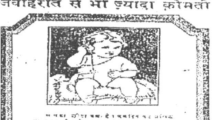Abstract
It is known to all that children-based products and services are reaching lucrative markets and receive a huge demand from a variety of segmentations. Advertisement through its campaign and promotion strategy is predominantly used by advertisers to portray children as the heart of selling points. The advertisers will seize and manipulate children portrayals in their ads in order to gain awareness from the specific target audience as well as to be accepted by the society. Advertisers should be smart in implementing competent advertising medium, such as the television commercial advertisement, magazine or newspaper advertisement, or outdoor advertisement. Hence, the flow of the message as well as the information is correctly delivered to the intended group. The power of children portrayal in advertisements is the main factor that influenced the consumer’s purchasing power in every product category. For instance, children images, visual on nutrition products, are often portrayed as energetic, brilliant, and cute. On the other hand, most of the advertisements picture children as bubbly, exciting, happy, fun, innocent, and pure. With the usage and the mixture of these characters, it creates attention to the readers. This chapter analyzes the content of press advertisements against children portrayals and stereotypes. Children, kids, and babies were made the selling point for products and services with a maximum of manipulation of the physical form and cuteness, which, as was seen, could deceive the consumer’s buying power. The focus of this research is to analyze the aspects of children role and stereotype, advertising appeal and persuasion as well as the creative strategy in relaying the issues and messages effectively to the consumers of the products and services of the press advertisements. To achieve the research’s objective, the method employed is a quantitative approach with the emphasis on content analysis. Hence, the analysis unit in this study is the advertisement which was gathered from The Star newspaper for 1 week, well defined as a subset of a sampling and representing accurate data measurement for this study.
Access this chapter
Tax calculation will be finalised at checkout
Purchases are for personal use only
Similar content being viewed by others
References
Call it kid-fluence. U.S. News & World Report. (30 July 2001), p. 32. Strasburger, Victor C. (2001, June).
Consumers International. (1999). Easy targets: A survey of television food and toy advertising to children in four Central European countries.
Crabb, P. B., & Bielawski, D. (1994). The social representation of material culture and gender in children’s books. Sex Roles, 30(2), 69–79.
Davidson, E. S., Yasuna, A., & Tower, A. (1979). The effects of television cartoons on sex-role stereotyping in young girls. Child Development, 50(2), 597–600.
Dumont, P. (2001). Temptation-free television for children? UNESCO Courier, 54(9), 44.
Furnham, A., Abramsky, S., & Gunter, B. (1997). A cross-cultural content analysis of children’s television advertisements. Sex Roles, 37(2), 91–99.
Goldstein, J. (1998). Children and advertising—the research. Commercial Communications, July: 4–7.
McDonald, M., & Lavelle, M. (2001). Call it kid-fluence. U.S. News & World Report, 131(4), 32.
McCarthy, M. S., & Mothersbaugh, D. L. (2002). Effects of typographic factors in advertising-based persuasion: A general model and initial empirical tests. Psychology & Marketing, 19(7–8), 663–691.
Macklin, M. C.,& Les, C. (1999). Advertising to children: Concepts and controversies. Thousand Oaks: Sage.
Pine, K. J., & Nash, A. (2002). Dear santa: The effects of television advertising on young children. International Journal of Behavioral Development, 26(6), 529.
Stern, S. R., & Mastro, D. E. (2009). Gender portrayals across the life span: A content analytic look at broadcast commercials. Mass Communication & Society, 7(2), 215–236.
Author information
Authors and Affiliations
Corresponding author
Editor information
Editors and Affiliations
Rights and permissions
Copyright information
© 2015 Springer Science+Business Media Singapore
About this paper
Cite this paper
Murad, K., Saahar@Saabar, S., Abdul Halim, A. (2015). Does Cuteness Sell? A Content Analytic Study of Children Portrayal in Press Advertisement. In: Hashim, R., Abdul Majeed, A. (eds) Proceedings of the Colloquium on Administrative Science and Technology. Springer, Singapore. https://doi.org/10.1007/978-981-4585-45-3_4
Download citation
DOI: https://doi.org/10.1007/978-981-4585-45-3_4
Published:
Publisher Name: Springer, Singapore
Print ISBN: 978-981-4585-44-6
Online ISBN: 978-981-4585-45-3
eBook Packages: Humanities, Social Sciences and LawSocial Sciences (R0)




